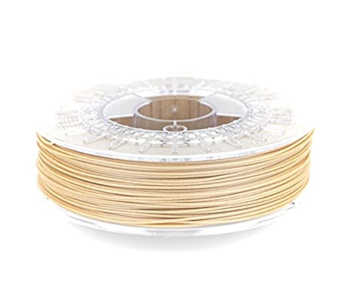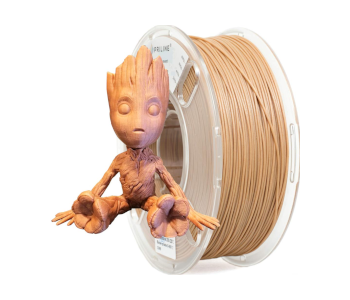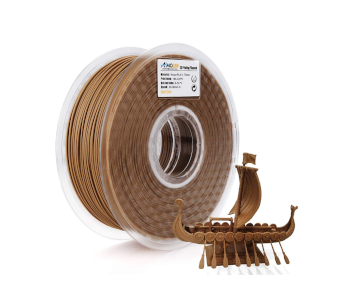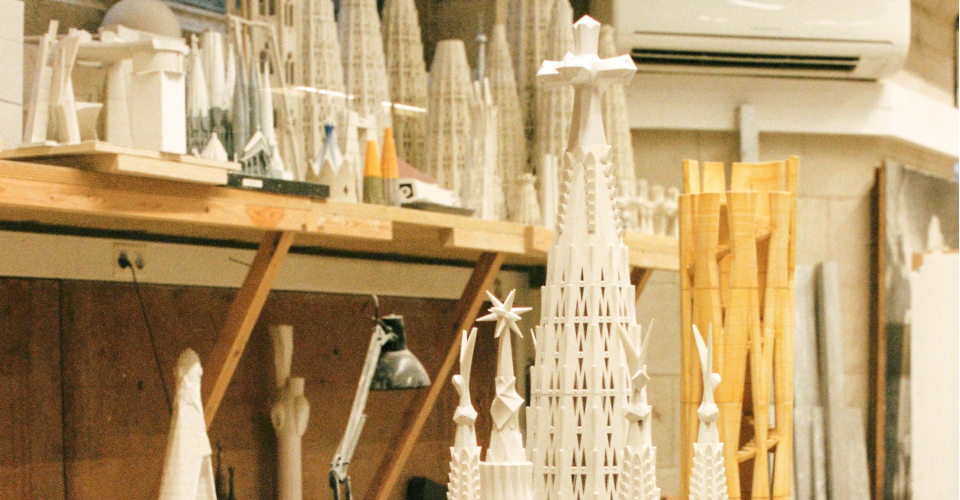A Detailed Guide to 3D Printing with Wood
Design freedom has always been cited as a major strength of 3D printing. However, there is a huge limitation on what you can create with 3D printing – the available materials. Up until a few years ago, all products of FDM-based 3D printing looked like plastic, which is to say they looked cheap and tacky.
That’s less of a concern now that composite filaments are readily available. By combining other materials with plastic filaments, you can now 3D print an object that simulates the look of something typically not 3D-printable. In this article, we’re taking a detailed look at one of these unconventional materials – wood.
How does one 3D print with wood?
Before 3D printing, the only way to create a customized project from wood would be cut or chisel it down. This subtractive manufacturing method required significant skill, had huge design limitations, and created a lot of waste material.
Additive manufacturing with wood may seem impossible until you realize its secret- the material isn’t entirely made of wood. In the case of 3D printing, the filament used is merely a PLA matrix with a suspension of very fine wood particles.
Most 3D printing filaments available today contain 3o to 40 percent in weight of wood fibers, with the balance all made of PLA. The PLA acts as a vehicle for the wood particles, allowing them to be shaped in ways that would have otherwise been very difficult for subtractive manufacturing.
The concept of composite filaments isn’t exclusive to wood. There are now 3D printing filaments that mimic the appearance of traditional manufacturing materials like metals, ceramic, marble, and carbon fiber among others. Even within the sub-set of wood filaments, there is some variety in the type of wood used. Whether you’re looking to 3D print something that looks like cedar, bamboo, pine, or olive, there should be a filament out there that’s especially suited for your needs.
The pros and cons of printing with wood
Wood might just be the most popular composite filament available today, so there’s clearly a market for it. However, there are a few drawbacks to any composite filament. Here are just a few things you’ll want to anticipate:
PROS:
Aesthetics
The main reason why you should even consider printing with a wood filament is its superior visual appeal. What makes wood especially suitable for composite filaments is that the layer lines that are naturally made by 3D printing simulate the appearance of wood fibers. This enhances the appearance of prints made with wood filament, helping them look like the real thing.
If you’re willing to go the extra mile and finish a wood print, then you can enhance its appearance significantly. Just like real wood, a wood print can be sanded smooth and treated with lacquer or varnish. You might even be able to customize the color of a wood print
Sustainability
The combination of PLA and wood in the wood filament is magical in that they are both sustainable materials. PLA comes from plant material and the wood fibers used come from real wood. On the production side, this means that wood filament comes from fully sustainable sources.
The disposal side is a bit of a gray area. Wood is certainly biodegradable, but the biodegradability of PLA is something that is not as absolute. However, wood filament can certainly be disposed of safely in an industrial composting plant.
Take note that not all composting plants are equipped to handle bioplastics. It’s best to ask the nearest composting facility just to make sure.
Ease of use
The major advantage of using PLA to create composite filaments is the fact that PLA is the easiest filament to work with. This ease-of-use factor transfers well to wood filaments. Wood filaments print at low temperatures, has no bed adhesion problems, and is not prone to warping.
Moreover, wood emits this nice burnt smell when it is heated especially if you’re printing with wood like pine or cedar. A word of warning, though – that nice smell can still come with microscopic plastic particles. Don’t actively inhale it, and make sure that you’re printing in a place with good ventilation.
CONS
Brittle filament
Infusing any solid particle with plastic makes the composite material a lot less ductile. This is true for wood filament and makes it a little more difficult to handle. Wood filament can snap off easily, especially if there are tight turns along the filament path from the spool to the feeder. This isn’t a huge disadvantage, but it does take some getting used to.
Expensive
Wood filament is a little more expensive than its base PLA equivalent, although not by much. If you’re buying a 1-kilogram spool, the difference is probably less than $10. However, this could be enough to warrant careful consideration when printing something with wood filament – this isn’t the kind of filament you will want to waste.
Not as strong as the real thing
If you expect the addition of wood fibers to PLA to make the composite material stronger, then you would be sorely disappointed. PLA, despite its lack of tensile strength, has good ductility and impact-resistance. The addition of wood reduces this property, making the resulting print overall more brittle. Take note that the wood material is present only in highly dispersed wood particles and does not really provide any strength upgrades.
All things considered, the inconveniences of working with wood filament is easily are easily offset by the benefits it provides when it comes to the quality of the finished product. There’s nothing quite like the appeal of a custom-designed figure that looks like it’s made out of real wood.
Where to buy wood filaments
Wood filaments are incredibly common nowadays. If you have a go-to popular filament brand, then they probably offer a wood filament product. That said, here are some of our favorite wood filaments that we recommend:
ColorFabb WoodFill

ColorFabb is one of the more creative filament brands today, so it’s no surprise that their wood filament is excellent. The product we have highlighted here is the standard WoodFill, but they also have BambooFill and CorkFill options. Each of these wood filament variants mimics the appearance of a different kind of wood. The downside of this wood filament line is that they are very expensive – almost twice the price of the other entries in this list.
PRILINE Wood PLA Filament

PRILINE offers both dark wood and light wood options, both of which look great and print well. PRILINE uses bamboo powder as the solid component for these filaments, resulting in finished prints with a very fine wood grain appearance. The advantage of buying a PRILINE wood filament is that they are very inexpensive do not cost a lot more than standard PLA.
AMOLEN Dark Wood Walnut

AMOLEN is another brand that sells fairly pocket-friendly wood filaments. While their standard wood-filled filament looks good, we’re partial to this dark wood walnut version. There’s something about the rich brown color of this filament that makes the finished print look so much more elegant. If you want your 3D printed to look like an old-timey artifact, then we suggest giving this filament a spin.
Tips on 3D printing with wood
Wood filament isn’t a particularly difficult material to work with, but here are a few tips to avoid its most common problems:
Use printer settings recommended by the manufacturer
While standard PLA printer settings should work well for wood filament, it’s still best to use the settings recommended by your filament’s manufacturer. In most cases, the optimal printing temperature would fall somewhere within the range of 170 to 220 C.
A heated bed is not necessary when using wood filament but having a layer of glue stick or blue painters’ tape on the print bed helps a bit. Still, it wouldn’t hurt to have a heated print bed set between 45 to 60 C.
Tweak with retraction settings
Stringing or oozing can often be a problem when working with wood filament (or any other composite filament). This happens because the presence of solid particles in the filament makes it difficult for the nozzle to maintain suction on the molten material. This can be an issue when the nozzle is traveling across wide gaps where it is not extruding.
The easiest solution to a stringing problem is to enable retraction in your printer settings. Even a retraction of 0.2 mm. can be a substantial help in this department. A better option would be to minimize the need for retraction – some slicers have an automatic feature for this.
Print with more layers
Setting your design to have more layers is often a compromise. It allows for finer details but also emphasize the visibility of layer lines and makes the print time much longer.
While there’s nothing you can do about the longer print time, the layer lines are something you don’t have to worry about as much with wood filaments. As we’ve mentioned, the layer lines are less prominent in this scenario and even add more charm to the final print. Go ahead and print with more layers if you have a wood filament loaded on your 3D printer – it usually leads to a better product.
Increase print speed to prevent clogging
Wood filament prints at low temperatures and typically have no layer-to-layer adhesion problems. This means that there should be no problem if your print at relatively high speeds – somewhere in the range of 65 to 75 mm/s. Not only does this help reduce printing time, but it also makes it less likely to run into clogging problems in your nozzle or extruder. This is a win-win situation, so go ahead and let that printer run wild.
Use a wider nozzle
Just about all composite filaments are abrasive simply because of the presence of solid particles in the plastic material. While wood is certainly less abrasive than metal or carbon fiber, it can still wear down on a standard brass nozzle.
If you plan on using composite filaments a lot, then it might be worthwhile to invest in an abrasion-resistant nozzle with a wider opening. A diameter of 0.5 mm usually works well for wood filament.
Final thoughts
Wood filament is something we consider an ‘old reliable’ when it comes to composite filaments. It’s inexpensive, easy to work with, and is nice to always have on hand. If you want to give your 3D prints a touch of elegance, then simply swap out that ABS or PLA with a wood filament.
Wood filament is also less problematic when it comes to the printing experience as it’s not as abrasive or dense as metal or ceramic. Bridges and overhangs generally fare well with wood filament, and you avoid the pesky changes in heating behavior that come up when printing with metal. If you’ve never tried printing with wood filament before, we highly recommend buying just one spool from our recommended brands just to give it a shot.





